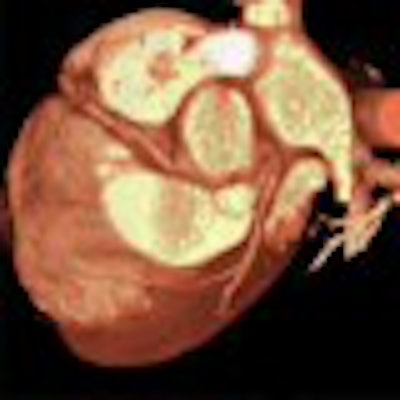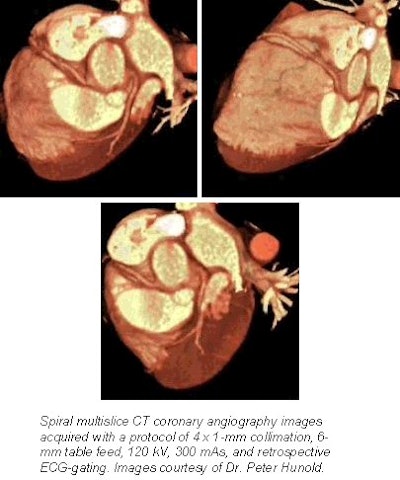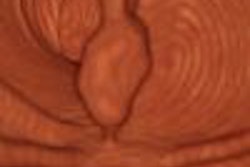
Multislice scanning is enabling CT to take off in new directions, such as cardiac imaging. But that extra functionality comes at a price -- MSCT provides up to seven times the radiation dose of electron beam CT (EBCT), yet offers only moderately better spatial resolution, according to German radiologists.
Noticing the increased use of multislice CT, Dr. Peter Hunold and colleagues from University Hospital in Essen, Germany, compared the radiation doses of both modalities in coronary calcium scoring and noninvasive coronary angiography in a phantom model. Using standard protocols, they compared the effective doses of five different imaging techniques:
- Calcium scoring with prospective ECG triggering (sequential technique) on MSCT.
- Calcium scoring in spiral technique with retrospective EKG trigger on MSCT.
- CT angiography with retrospective ECG trigger on MSCT.
- Calcium scoring on EBCT.
- CT angiography on EBCT.
A Somatom Plus 4 Volume Zoom multislice scanner (Siemens Medical Systems, Iselin, NJ) with four detector rows, a tube rotation time of 0.5 seconds, and a time resolution of 250 ms was used for the study. The C-150 XP EBCT unit had a 100-ms time resolution (Imatron, South San Francisco, CA).
An anthropomorphic phantom model weighing 70 kg and measuring 170 cm was used to measure radiation dose to the bone marrow, lung, colon, thyroid gland, esophagus, female breast, stomach, liver, bladder, ovaries, and testes.
 |
The phantom, made up of 35 2.5-cm slices, was equipped with 66 lithium fluoride thermoluminescent dosimeters, two at each of 33 organ sites. The researchers calculated the effective doses for male and female patients using weighting factors set by the International Commission on Radiological Protection (ICRP 60).
For both calcium scoring and noninvasive angiography, the researchers found that multislice CT protocols delivered a substantially higher radiation dose than EBCT protocols. Also, they found significantly varying radiation doses between the different multislice CT protocols that were used:
- EBCT, 3-mm collimation, 3-mm table feed, 130 kV, 63 mAs
- Sequential multislice CT, 4 x 2.5-mm collimation, 10-mm table feed, 140 kV, 36 mAs
- Spiral multislice CT, 4 x 2.5-mm collimation, 6.7-mm table feed, 120 kV, 133 mAs
Radiation dose = 1.0 mSv male, 1.3 mSv female.
Radiation dose = 1.5 mSv male, 1.8 mSv female.
Radiation dose = 3.0 mSv male, 3.6 mSv female.
The results for coronary artery angiography were as follows:
- EBCT, 3-mm collimation, 2-mm table feed, 130 kV, 63 mAs
- Spiral multislice CT, 4 x 1-mm collimation, 6-mm table feed, retrospective ECG-gating 120 kV, 400 mAs
Radiation dose = 1.5 mSv male, 2.0 mSv female.
Radiation dose = 10.9 mSv male, 13.0 mSv female.
120 kV, 300 mAs
Radiation dose = 7.6 mSv male, 9.2 mSv female.
140 kV, 200 mAs
Radiation dose = 6.7 mSv male, 8.1 mSv female.
"You can see that the female protocols obtained a higher dose than the male protocols," Hunold said in a presentation at the 2001 RSNA meeting in Chicago. "This is due to the breast situated in the middle of the scan volume."
The researchers found that the female breast, lungs, and esophagus received the highest radiation dose no matter which CT technique was used, but the EBCT protocols still provided a lower dose in every case, Hunold said.
Hunold and his colleagues concluded that multislice may offer better spatial resolution, but it comes at the price of higher radiation dose, in some cases nine times higher than EBCT dose. They recommend the development of standardized and optimized MSCT protocols before multislice CT becomes routine in cardiac imaging.
By Leslie FarnsworthAuntMinnie contributing writer
February 6, 2002
Related Reading
Multislice scanning cuts radiation dose in CT colonography, January 10, 2002
CT calcium scoring works, but what does it mean?, January 8, 2002
Significant difference in radiation dose found between single- and multislice CT, November 25, 2001
CT sees growth, and new concerns over radiation dose, November 25, 2001
Do CT and EBCT calcium scores weigh apples and oranges?, October 12, 2001
Copyright © 2002 AuntMinnie.com




















